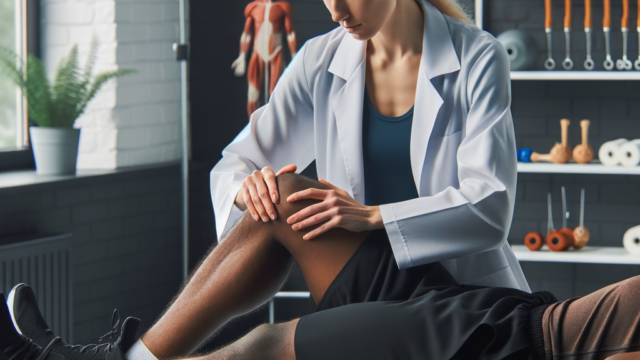Sustaining an ACL injury can significantly impact an individual’s physical and emotional well-being. Understanding the path to recovery from such an injury is crucial. In this article, we’ll explore the journey of ACL rehabilitation, emphasizing the essential steps involved and the valuable assistance provided by Sydney’s top physiotherapists throughout this process.
Understanding ACL Injury
What is the ACL?
The anterior cruciate ligament (ACL) is a vital ligament in the knee, crucial for maintaining stability and facilitating smooth movement. It connects the thigh bone (femur) to the shin bone (tibia) and plays a pivotal role in supporting the knee joint during various activities.
Causes of ACL Injuries
ACL injuries commonly occur during sports activities that involve sudden stops, changes in direction, or direct impact to the knee. Non-contact incidents such as twisting or pivoting motions can also lead to ACL physio sydney. Factors such as poor conditioning, improper landing techniques, and inadequate warm-up may increase the risk of ACL injury.
Diagnosis and Assessment
Symptoms of ACL Injury
Signs and symptoms of an ACL injury often include a popping sensation in the knee, swelling, instability, and difficulty bearing weight. Some individuals may experience limited range of motion and pain during movement, indicating a potential ACL tear.
Physical Examination and Imaging Tests for Diagnosis
Diagnosing an ACL injury typically involves a thorough physical examination by a healthcare professional, supplemented by imaging tests such as magnetic resonance imaging (MRI). These tests help confirm the diagnosis, assess the extent of the injury, and guide appropriate treatment strategies.
Initial Treatment and Management
RICE Protocol: Rest, Ice, Compression, Elevation
The initial management of an ACL injury often follows the RICE protocol:
- Rest: Avoiding activities that exacerbate the injury and allowing the knee to heal.
- Ice: Applying ice packs to the affected area to reduce pain and inflammation.
- Compression: Using compression bandages or wraps to minimize swelling and provide support to the knee.
- Elevation: Elevating the injured leg above heart level to facilitate fluid drainage and reduce swelling.
Use of Braces and Crutches
In some cases, the use of knee braces and crutches may be recommended to stabilize the knee and alleviate pressure on the injured ligament. These supportive devices help promote healing and prevent further damage to the knee joint.
Surgery: When is it Necessary?
Criteria for Considering Surgical Intervention
The decision to undergo ACL reconstruction surgery depends on various factors, including the individual’s activity level, age, and the severity of the injury. Surgery is typically recommended for individuals who experience significant knee instability, engage in high-demand physical activities, or fail to respond to conservative treatments.
Types of ACL Reconstruction Surgeries
ACL reconstruction surgeries involve replacing the torn ligament with either autograft tissue (taken from the patient’s body) or allograft tissue (obtained from a donor). Common graft options include the patellar tendon, hamstring tendon, and quadriceps tendon. The choice of graft depends on factors such as patient preference, surgeon expertise, and desired outcomes.
Role of Physiotherapy in ACL Rehabilitation
Importance of Physiotherapy in the Recovery Process
Physiotherapists play a crucial role in guiding individuals through each phase of ACL rehabilitation, providing personalized treatment plans and continuous support. They utilize a combination of manual therapy techniques, therapeutic exercises, and modalities to optimize recovery and restore function.
Specific Exercises and Techniques Used by Physiotherapists
Physiotherapy interventions for ACL rehabilitation may include:
- Manual Therapy: Hands-on techniques such as joint mobilization, soft tissue massage, and stretching help improve joint mobility and alleviate pain.
- Therapeutic Exercises: Targeted exercises focus on improving strength, flexibility, balance, and proprioception, addressing specific deficits identified during the assessment.
- Modalities: Additional modalities such as ultrasound, electrical stimulation, and therapeutic taping may be used to complement exercise therapy and facilitate tissue healing.
Nutrition and Lifestyle During Recovery
Importance of Proper Nutrition and Hydration
A balanced diet rich in nutrients such as protein, vitamins, and minerals is essential for supporting tissue repair and recovery. Adequate hydration is also crucial for maintaining optimal physiological function and promoting healing.
Lifestyle Adjustments to Aid Recovery
During the recovery period, individuals should prioritize rest, sleep, and stress management to facilitate the healing process. Engaging in low-impact activities such as swimming or cycling can help maintain cardiovascular fitness without placing excessive stress on the knee joint. Avoiding smoking and excessive alcohol consumption is also recommended to promote optimal healing and recovery.
Preventing Future ACL Injuries
Strategies to Reduce the Risk of Re-injury
To minimize the risk of re-injury, individuals should:
- Gradually progress through rehabilitation protocols under the guidance of a physiotherapist or healthcare professional.
- Participate in regular strength and conditioning programs to improve muscular strength, endurance, and flexibility.
- Use appropriate protective equipment (e.g., knee braces) during sports activities to support the knee joint and reduce the risk of trauma.
Incorporating ACL Injury Prevention Exercises into Fitness Routines
Integrating specific exercises targeting lower extremity strength, flexibility, and neuromuscular control into fitness routines can help reduce the risk of ACL injuries. Emphasizing proper landing techniques, dynamic warm-up exercises, and sport-specific agility drills can enhance biomechanical efficiency and reduce the likelihood of non-contact ACL injuries.
Conclusion
The journey of ACL rehabilitation requires a multidisciplinary approach, encompassing medical expertise, physiotherapy interventions, and individual commitment. By understanding the essential steps involved and collaborating with Sydney’s top physiotherapists, individuals can navigate this road to recovery with confidence, ensuring a successful return to an active and fulfilling lifestyle.
